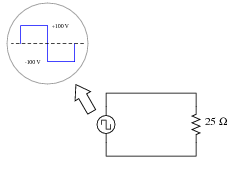Other AC circuits
Problem:
(a) Show that in an AC circuit (V = Re(V0exp(iωt)) with
resistive and reactive circuit elements the
average power dissipated is Pavg = ½Re(VI*) = I2rmsR.
(b) Calculate the average power dissipated by a 25 Ω resistor, when powered by a square-wave
with a symmetrical amplitude of 100 volts and a frequency of 2 kHz:

Solution:
- Concepts:
AC circuits
- Reasoning:
We have to average the instantaneous power over one cycle.
- Details of the calculation:
(a) I = Re(I0exp(i(ωt + φ)) = I0cos(ωt
+ φ)
V = Re(IZ) = Re(I(R + iX)) = I0Rcos(ωt + φ) - I20Xsin(ωt
+ φ)
Instantaneous power: P = IV = I02Rcos2(ωt
+ φ) - I02Xsin(ωt + φ)cos(ωt + φ)
Averaged over one cycle, <cos2(ωt)> = ½, <cos(ωt)sin(ωt> = 0.
Therefore Pavg = ½I02R = I2rmsR.
There is no energy loss in the reactive part.
In complex notation: VI* = I02(R + iX)), ½Re(VI*)
= ½I02R = I2rmsR.
(b) There is no reactance in the circuit. P(t) = I(t)V(t) = I2(t)R
= 400 W
Pavg = I2rmsR = V2rms/R
= 400 W (The formula still works.)
Problem:
A heavy block is attached to the ceiling by a
spring that has a force constant k. A conducting rod is attached to
the block. The combined mass of the block and the rod is m. The rod
can slide without friction along two vertical parallel rails, which
are a distance l apart. A capacitor of known capacitance C
is attached to the rails by the wires. The entire system is placed in
a uniform magnetic field B directed as shown. Find the period T of
the vertical oscillations of the block. Neglect the electrical
resistance of the rod and all wires.

Solution:
- Concepts:
Motional emf, AC circuits
- Reasoning:
If the block oscillates with angular frequency ω, then the motional emf induced in the circuit has angular frequency
ω. Since the circuit has no resistance the sum of the motional
emf and the voltage across the capacitor must be zero. The capacitor
must charge and discharge appropriately and we can find the current flowing in the AC circuit. Given
the current, we can find the total force on the rod.
- Details of the calculation:
We neglect the self inductance of the circuit.
Let the z-axis be the vertical axis, let z = 0 denote the
equilibrium position of the rod, and let the upward direction be the positive
z-direction.
Assume the mass is oscillating with angular frequency
ω.
Let z = z0exp(iωt).
[The real part of the equation describes the motion.]
Then v = iωz0exp(iωt).
[z and v are 90o out of phase.]
The motional emf is ε
= vBl = iωz0Blexp(iωt).
[The emf and v are in phase.]
When the mass moves through its equilibrium position into
the positive z-direction, v and the emf have their maximum values, the left
plate of the capacitor is positively charged.
As z increases, v and the emf decrease, and a current flows from left to
right through the rod as the capacitor discharges.
I = ε/ZC,
ZC = 1/(iωC) is the impedance of the capacitor.
I = -ω2z0BlCexp(iωt).
The force on the wire therefore is F = IlB in the upward direction.
F = ω2z0B2l2Cexp(iωt)
= ω2B2l2Cz.
The force due to the spring is F = -kz, so Ftotal = -(k -
ω2B2l2C)z
= -k'z,
ω = (k'/m)½
= [(k - ω2B2l2C)/m]½.
ω2 = (k -
ω2B2l2C)/m. (1 + B2l2C/m)ω2
= k/m.
ω2
= k/[m + B2l2C]. T = 2π/ω
= 2π/[k/[m
+ B2l2C]]½ = 2π[m
+ B2l2C]½/k½.


